
Atlas F1 Technical Writer
From the first session on Friday to the last few metres of the race, the Austrian Grand Prix became the most talked about F1 weekend in recent years. But while the Ferrari's team orders stole the limelight, the technical developments on some of the cars made the Austrian race one of the most significant this year. Craig Scarborough reviews the cars and their performance
As the A1-Ring places a heavy load on engines, it was not surprising to see massive engine failures throughout qualifying and the race. On Saturday, Jarno Trulli's Renault expired before the last corner and left oil all over the track, bringing out the red flag. In the race, Oliver Panis's Honda engine seized, slewing his car to a halt on the main straight, which resulted in the safety car being deployed to retrieve the stricken BAR.
Lastly, as with last year, the smooth slippery surface caught out the drivers, and just about everyone went off the circuit at some stage during the weekend. Michael Schumacher even spun off in qualifying - a very rare spectacle. The track improved over the weekend, but the tricky surface caused problems at the start of the race and even played its part in the incidents at the restart, after the safety car went back into the pits.
Front Wing Design
In the pre-race build up, a few teams alluded to some new aerodynamic parts set to debut in Austria. In previous race weekends, Jordan had run a flat front wing to replace the complex version run since the start of 2001. The flat version was brought to Austria along with a new curved wing, and both versions were run, with a preference to the older version. Williams provided the biggest surprise - they had a totally new front wing package, unseen in testing or previous races.
There is a growing consensus in aerodynamic design among F1 teams, and Williams now joins all but McLaren in using the enclosed "Bucket" format brake ducts, eschewing their traditional scoop attached to the upright. When the front wing rules were changed for the 2001 season, there were several philosophies adopted in the layout of the wing. The outer sections of the wing were raised to meet a new minimum height above the floor of the car, but this minimum height was waived for the middle section of the wing, which was allowed to be as low as the floor of the car.
Ground effect and pitch sensitivity
As a wing is placed nearer the ground it starts to work in "ground effect". This interaction with the ground provides an incremental gain in downforce as the wing gets nearer to the ground, up to the point that the flow through the gap between the wing and ground chokes. When at a constant height from the ground the wing can be much more efficient.
However, F1 cars pitch - that is, go up and down - over bumps, under braking or acceleration, and when the aerodynamic load is changed from the wings. As the wing pitches up and down, the amount of downforce it creates varies, and if the change in downforce is large, then the car's handling becomes less predictable. This effect is known as 'pitch sensitivity'.
Teams realised that they could lower the middle section of their wing to gain more downforce from the lower wing height at the expense of pitch sensitivity. Therefore, throughout 2001, teams adopted three main front wing strategies:
The Heidfeld - Sato Crash
There was a safety car period following the Honda blow up that left Panis stranded on the main straight. On lap 27, the safety car pulled in and the cars were racing once more. However, Nick Heidfeld lost control of his Sauber as he was forced to brake too hard on discs that were still cold after running behind safety car, in a manner reminiscent of the start line incident in Australia. The car took to the grass on the inside of the circuit and, carrying a lot of momentum, cut across the paths of Juan Pablo Montoya and Takuma Sato several places up the field.
The Sauber missed the Williams's back, speared backwards into the side of the Jordan, and sent both cars into the gravel trap in an explosion of carbon fibre and smoke. Heidfeld was able to jump out of his car; the rear impact structure absorbed the impact, but the same structure ripped open the monocoque of the Jordan around Sato's Knees. There were fears for Sato after the medics took time to extricate him from the car, but it subsequently transpired that he only suffered bruising and cuts to his knees and he suffered no broken bones or concussion.
Zanardi's accident happened at much higher speeds and the Italian's car was destroyed, resulting in the loss of both his legs. Sato's accident was, thankfully, at much lower speeds, but the location of the impact just forward of the cockpit opening is the most vulnerable point on the car for the driver in an accident. Both Michael Schumachers' and Olivier Panis leg breaking accidents resulted in the monocoque being ripped open in this area.
The fact that both drivers emerged largely unscathed form the crash at Austria demonstrates that safety in F1 as well as the ever increasing impact-testing of the monocoque, have been successful - the adoption of side and rear impact crash structures played a large part in the outcome of the accident.
This component has to withstand the rear impact tests and take the load from the rear wing. It is made from thick layers of carbon fibre and the tip is almost solid carbon fibre. Unlike the nose cone, there is no minimum cross section for the tip of the structure. This made it easier for the component to puncture Takuma's monocoque in the crash. Hence, a rule revision for 2003 should be called for.
Tyres
Austria provided a similar weekend to the previous races for the tyre manufacturers. Bridgestone's teams are finding the tyres to match their cars and the circuit much better. At the front, Michelin runners Williams and Renault were able to perform equally with the Bridgestone's, while McLaren still struggled a little with the tyres, but overall they were in a more competitive situation this weekend.
Bridgestone's tyres worked well straightaway on Friday, the clean track suiting the Japanese rubber much more than the Michelins, which came in better later in the day. The rest of the weekend saw the manufacturers fairly equal, against the rise of Sauber, Arrows and Jordan - suggesting that the Bridgestone tyres were allowing the teams to run higher than in pervious races. Some Michelin runners found that older scrubbed tyres were providing more grip in qualifying and the scrubbed tyres were again preferred for the race.
Most Michelin runners scrubbed their race tyres in on Friday, as soon as they had made the decision on which of the two optional tyres they would race. Again, this practice causes unhappiness between the tyre suppliers, as the rules limit the number of tyres and laps allowed on Saturday and Sunday. According to the Bridgestone runners, scrubbing in these tyres on Friday is outside the spirit of the rules.
Team by Team
Ferrari
Ferrari ran the same configuration as in Spain, with the serrated bargeboards. Friday morning left the rest of the field trailing Michael Schumacher by over a second and the weekend looked over for the rest of the field. But as expected, as the track improved the Williams cars were better able to challenge the Ferrari and the rest of the filed closed up considerably.
Qualifying again saw Michael struggle in comparison to Rubens, stating that he had a problem with his race car, although he couldn't say what it was. "Michael never got a clean lap, partly because of the car," technical director Ross Brawn later explained. "He was a bit unhappy with the brakes and as we could not solve the problem immediately we decided to use the spare."
There were no "technical" problems for the team in the race. Brawn had decided that two-stop strategy would be a good choice for the race, since Michael Schumacher needed to pass Ralf at the start and Ferrari worried that if he was followed closely to the pitstop on a one-stop strategy, the team might lose the race to a later stopping car, as in 2001. Strategically, the fastest lap times and offset pit windows would counter any other team's offence.
Williams
Considering the long lead times and exhaustive testing requirements demanding for new development in F1 nowadays, Williams did exceptionally well to debut a new front wing and have it perform so well that it stayed on both cars all weekend.
The new front wing has a slight dip across its span, and to mount the lower centre section of the wing, the drop plates featured alloy extensions reaching down the extra few centimeters.
Williams also had a new floor and revised bargeboards, both appear similar in profile and layout, so the changes must be in the minor details and shaping.
Also on the technical side, Patrick Head finally rubbished the reports of the radical new gearbox developments raised in the press. "Well, it's the first I've ever heard of it, apart from quotes in newspapers," he said in a press conference, adding that the rumoured manufacturer of the gearbox was "a German company who has made a small number of gears for us but that's about it."
Williams had a normal Friday practice, preparing for the race and evaluating the two Michelin tyre options. Both drivers were playing with the balance of the car and felt improvements had been made.
The team was much closer to Ferrari on Saturday and in qualifying capitalised on Michael Schumacher's problems to split the Ferraris. Ralf had the cleaner session, as Juan Pablo Montoya had a technical problem with his race car and once again had to take to the T-Car to qualify.
In the race, fortune befell Juan Pablo Montoya for a change, as he was on a very heavy fuel strategy and the safety car periods eased the burden on his car and closed his the gap to the leading Ferraris. Montoya also stayed out the longest, as his tyres were lasting well enough not to be changed during the fuel stop, and that allowed him up into 3rd position. Ralf Schumacher had a less eventful race, but he ran without problems all the way to the finish.
McLaren
Qualifying brought equally trouble free running from the team, but both drivers were beaten by a Sauber to end up in 6th and 8th. These positions were "reflecting our current state of competitiveness," according to Ron Dennis, which in itself is a worry for a team who was at the top of the Championship in recent years. Equally worrying was Raikkonen's retirement on Lap 6 with another engine failure.
Renault
The team was very much off form on Friday, and in an unchanged R202 both drivers did the usual program but ended up 14th and 17th. "I had a difficult time today, struggling with the balance which is something we need to work on some more," Jenson Button said. "We still haven't finalised our tyre choice, but we know the direction we need to work in tomorrow. I now have to wait for the next sessions to try out what we hope will be the answers to our difficulties."
Saturday did not provide any answers for Button or his teammate, Jarno Trulli. Halfway through qualifying Trulli's engine let go in a big way and the car spun to a halt by the pit entrance, and several cars immediately went off on the oil trailing form the flaming car. Button, on the other hand, simply couldn't get the car to work as he'd like, with traffic making his afternoon even worse.
The race was a daunting prospect for the team so far down the grid, but Trulli had a competitive run up until he retired on lap 45, while Button ran up with the front of the midfield but was unable to finish better than 7th.
Sauber
With the A1 Ring being a power circuit, Sauber had on hand a new specification Ferrari engine (badged as a Petronas). Driver Nick Heidfeld said the unit "should be a bit stronger and that will help us, especially on this circuit here," and explained the engine was from the Ferrari F2001. "it is something that was used last year. We will use last year's Ferrari engine all year and we will not get the new [2002] spec."
Sauber also announced they had some new aerodynamics parts - a front wing, undertray and engine cover - but if they were used over the weekend, it was impossible to see any major differences from the old version.
Whatever new parts or testing were contributing, Friday started off with a bang for the Swiss team as the drivers put in some blistering time to finish 3rd and 4th fastest. The car looked well planted on the road all weekend, which highlighted the difference in the drivers styles: Nick Heidfeld cornered with well planned lines and never looked out of control or having to react to the car, while Felipe Massa never cornered on the same line twice, getting out of all sorts of problems with sheer car control and reflexes. It is not surprising that Massa went off the track several times on Friday, but such was the Sauber's poise that he never had a truly scary moment, aside from a trip across the gravel to avoid a slow running McLaren.
Qualifying returned the Saubers to the front of the grid, finishing up in 5th and 7th, separated by a tenth of a second. Neither felt they got the perfect lap in, either due to traffic or driving errors.
With the excellent pace and grid positions both drivers expected the race to go well. However, despite qualifying ahead of the midfield pack and making great start, Massa was bumped in the first corner and seven laps later retired with suspension damage. Heidfeld also made a great start and was running with Coulthard, as the safety car peeled off as he lost control of the car avoiding Alex Yoong's Minardi and set off the accident with Sato.
Jordan
There was a lot new on the Jordan's car this weekend - changes included a D-spec Honda engine, the new rear wing from the Spanish GP, and two new front wings. Slightly revised bargeboards completed the new Jordan aerodynamic package.
The flat front wing appears totally flat, unlike the subtle anhedral of the Williams version, and the shape of the outer sections of the flaps have a large surface area but retain the overall width of the older stepped wing. The drop plates are much shorter, as the centre of the wing is higher. They now return to a vertical position as on the car at its launch - the tip of the nose cone appears to have a different shape, but this is an optical illusion as the drop plates mount under the nose in a different position.
The curved front wing uses a similar profile as the flat wing in plan view, but viewed from ahead the wing uses a broad curve to mimic the design Ferrari have used this year. Splayed drop plates are used from the older format wing to mount this wing.
Also differing from previous front wings are the endplates. Their shape is taller and squarer, without the rounded front edge and cutouts. There is still a coved section to the rear, a narrow flip up along the outside of the plate and a slight lip along the bottom edge. A small "delta" fin is retained on the inside of the plate from the older version, but this fin is much smaller than the version Ferrari or Sauber use.
On Friday, both drivers gave positive feedback on the new front wings, but still found the car lacking grip on the slippery track, causing some mid corner oversteer. "We did some good back-to-back aero tests and I think the new wing is a positive step for the EJ12," Takuma Sato stated later.
Tricky track conditions lead to Giancarlo Fisichella spinning and lodging his car in the gravel, losing him track time, while Sato's engineers took the car's set up down a blind alley, losing him some time while they returned to earlier settings.
Qualifying also highlighted the trouble the drivers had setting up the EJ12 with the new wings. Moreover, unusually for a Bridgestone runner, Jordan found a mix of new and scrubbed tyres to be "the best set-up compromise," according to Fisichella.
For the race, Fisichella opted for the curved wing while Sato preferred for the old stepped wing.
BAR
The new technical innovation for Bar was the new "D" spec Honda engine, using a new but undisclosed material for the Block. The new engine provides more power at the same revs as the "C" spec unit, and was also used by Jordan this weekend.
After a better run in the warm up, Jacques opted for a two stop strategy in the race and for much of the opening stint was the fastest man on the track, as his lighter fuel load allowed him to make up places. This lighter Fuel load helped him off the lights, but too many cars going through the tight first corner lead to an incident with Heinz Harald Frentzen in the Arrows and Villeneuve was given a drive-by penalty for causing the accident. This cost him several places and although he ran just out of the points at the end of the race, his Honda engine let go after a few laps of diminishing hydraulic pressure. Panis had a more rapid demise of his Honda engine, later saying: "On the 3rd lap I felt something happen with the car; it suddenly felt a little strange. I kept pushing but in the end the engine blew as I was coming down the straight to start my 23rd lap."
Jaguar
Running the softer Michelin tyres, Jaguar found the car worked better than expected on Friday. "I think we are a little bit better than we normally are today," said Eddie Irvine. "Michelin have come with a tyre that's right on the limit, the softer of Michelin's two options has a clear advantage." The handling of the car was good this weekend too, and Irvine added that "some days it doesn't actually feel bad. The thing that's always a problem is entry instability, and we don't have so much mid-corner understeer here, which is unusual."
The understeer had returned for Saturday. though. "On the third run the car understeered massively," he said. "We didn't change anything, so we thought OK, it must be an odd set of tyres. I changed the tyres and the car felt good." Pedro de la Rosa was having suspension problems and needed a wishbone replacement. "I did my time on the third run," he said. "It was the only one I didn't mess up."
In the race, de la Rosa retired early on lap one with a technical problem, and Irvine retired on lap 38 with a hydraulic problem.
Toyota
Toyota came to Austria with a new front wing with the intent to use it if they felt the car was not on the pace. On Friday, Allan McNish went quickly straight away despite the slippery track not suiting the Toyota or its Michelin Tyres. Eventually Toyota did not end up using the new front wing and stated it was because it had not had enough development. Mika Salo was on a different program and only ended up in 19th place.
For Qualifying, both drivers got the set up they wanted and despite not getting clear runs on a busy Track ended up 10th and 14th. Gustav Brunner later commented: "I am very pleased that we have made our third top ten qualifying position in only our 6th race. The A1-Ring has tended to suit our car a bit better than other circuits and this has been reflected in the excellent 10th and 14th positions that Mika and Allan managed today."
Before the weekend started Toyota's stated aim was to get both cars to the finish. They achieved this and with Jacques Villeneuve's retirement on the last lap the team were promoted to 8th and 9th. Both drivers ran a clean, trouble free race and despite not making the best calls on strategy during the safety car period the team came away pleased with "another strong performance from the whole team," according to team chief Ove Andersson.
Arrows
The team is awaiting more updates to the car, starting with a revised front suspension for Monaco. Nevertheless, the drivers were enjoying the grip from the little car and Bridgestone tyres immediately on Friday. Enrique Bernoldi ended up 6th and happy with the balance and overall performance despite a puncture, while Heinz Harald Frentzen also had "basically a good day," but a like most other drivers had an off which damaged the floor of the car and required a speedy change, duly carried out by the mechanics.
Frentzen went off the road again in Qualifying as a result of running over the oil just laid down by Trulli's Renault. Some damaged parts were changed on the car and he qualified 11th, while Bernoldi remained happy with the car and followed his teammate in 12th, just 5 hundredths behind.
But the close qualifying also lead to the drivers' problems in the race. Bernoldi nudged the rear of Frentzen, who was then involved with Villeneuve and ran off the track. This damaged the diffuser and Frentzen struggled with oversteer throughout the race. Bernoldi retired with a broken wishbone from the accident, and Frentzen ran to end in 11th place.
Minardi
With revised wing mounting as insurance against more freak failures as in Spain, Minardi were otherwise unchanged for this race.
A curious outcome of running on Friday was Alex Yoong being faster than teammate Mark Webber. He covered over 50 trouble free laps on Friday, honing chassis balance, fine-tuning software and comparing tyres. "Mark didn't quite get the handling of his car as he would have liked it, but still did his usual professional job and will undoubtedly improve his times tomorrow," Stoddart said.
The team's chosen tyres proved troublesome on Saturday, while Yoong also experienced brake problems. Nevertheless, both drivers were certain there is more to come from the car, than the 21st and 22nd places suggested.
In the race, Webber failed to get off the line and had to start manually, well behind the pack. He caught the trailing group and in the confusion after the safety car he thought he was racing cars for position rather than being lapped. He received a drive-through penalty for that, and ran otherwise trouble free to the end. Yoong struggled with Michelin tyres that had insufficient scrubbing beforehand, his over-braking at the restart triggered the Heidfeld-Sato incident and he eventually retired with an Asiatech engine related problem on Lap 42.
The Austrian Grand Prix weekend brought new aerodynamic parts, that signalled a major change in concept for two teams. The race itself also featured an one of the biggest tests of impact protection seen in Formula One, when Nick Heidfeld's Sauber trashed into the Jordan of Takuma Sato - only to see both drivers leave virtually unscathed.



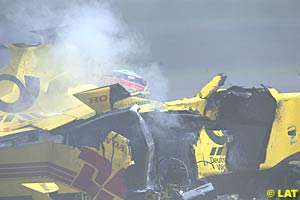 The accident was a shocking recreation of the accident that befell Alex Zanardi on the German ChampCar race last year. Zanardi spun on the exit to the pits and ended up on the track, where his car was hit by the nose of another car, in around the same area as Sato's car was hit in Austria.
The accident was a shocking recreation of the accident that befell Alex Zanardi on the German ChampCar race last year. Zanardi spun on the exit to the pits and ended up on the track, where his car was hit by the nose of another car, in around the same area as Sato's car was hit in Austria.
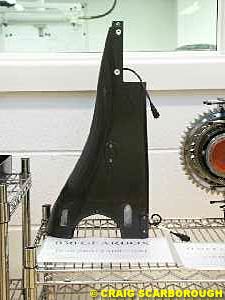 However, there are lessons to be learnt from any crash, and the fact that the monocoque was punctured should give rise to detail amendments to the monocoque impact tests. More importantly, the design of the rear impact structure should be looked at; the rear structure is mandated to be able to absorb specified directional impacts. The rear crash structure extends from the rear of the gearbox and thins to a wedge shape above the diffuser to form the rear wing mount.
However, there are lessons to be learnt from any crash, and the fact that the monocoque was punctured should give rise to detail amendments to the monocoque impact tests. More importantly, the design of the rear impact structure should be looked at; the rear structure is mandated to be able to absorb specified directional impacts. The rear crash structure extends from the rear of the gearbox and thins to a wedge shape above the diffuser to form the rear wing mount.
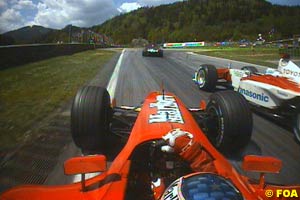 The grip shown by the Ferrari around the opening sequence of corners was beyond any other car on the grid; they came near the top of the speed traps as well, underlining the superiority of the F2002. Both drivers had off-track moments due to the gripless tarmac - Rubens Barrichello locked a wheel under braking and ran off, while Michael "had a few little excursions into the gravel," though quickly adding that "on this circuit that is quite normal."
The grip shown by the Ferrari around the opening sequence of corners was beyond any other car on the grid; they came near the top of the speed traps as well, underlining the superiority of the F2002. Both drivers had off-track moments due to the gripless tarmac - Rubens Barrichello locked a wheel under braking and ran off, while Michael "had a few little excursions into the gravel," though quickly adding that "on this circuit that is quite normal."
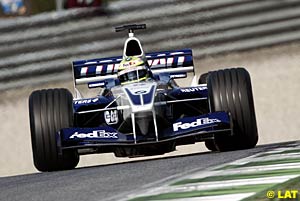 As with Jordan, the endplates are all new, being a squarer format with a triangular cut out. They sweep in between the front wheels more to allow a coved shape towards the rear edge. The front of the wing appears a few centimeters narrower as a small lip has now been formed along the bottom of the endplate. Still retained on the endplate are a narrow flip up and fences under the wing leading to the bargeboards.
As with Jordan, the endplates are all new, being a squarer format with a triangular cut out. They sweep in between the front wheels more to allow a coved shape towards the rear edge. The front of the wing appears a few centimeters narrower as a small lip has now been formed along the bottom of the endplate. Still retained on the endplate are a narrow flip up and fences under the wing leading to the bargeboards.
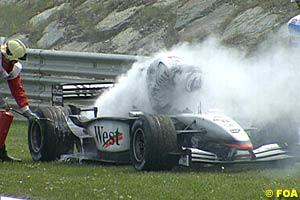 No developments were announced or were visible on the McLarens in Austria. The cars didn't look well balanced around the taxing corners, with Kimi Raikkonen sawing at the wheel around the opening series of bends. The team did the usual tyre selection work on Friday and were unclear as to their true competitiveness, with David Coulthard stating that "we are not yet where we want to be and it's difficult to estimate where we are compared to the rest."
No developments were announced or were visible on the McLarens in Austria. The cars didn't look well balanced around the taxing corners, with Kimi Raikkonen sawing at the wheel around the opening series of bends. The team did the usual tyre selection work on Friday and were unclear as to their true competitiveness, with David Coulthard stating that "we are not yet where we want to be and it's difficult to estimate where we are compared to the rest."
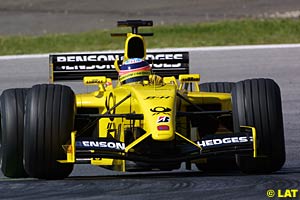 The two front wings are a major revision for Jordan, and the team brought a new flat front wing and a curved version.
The two front wings are a major revision for Jordan, and the team brought a new flat front wing and a curved version.
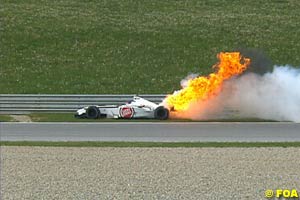 A hard work's award goes to Oliver Panis, who completed 66 laps on Friday as he experimented with set-ups. While it is not a good sign that a car needs so much work to find a set-up, the continued reliability and eventual set-up boded well for Qualifying. Jacques Villeneuve lost some time on Friday as he wanted changes made to the car which was more time consuming, but he wasn't happy with the car even after the changes were made, and come qualifying on Saturday, he was still unable to extract enough speed from the car. Meanwhile, Panis had a much better session and was the only Honda runner to qualify in the top ten.
A hard work's award goes to Oliver Panis, who completed 66 laps on Friday as he experimented with set-ups. While it is not a good sign that a car needs so much work to find a set-up, the continued reliability and eventual set-up boded well for Qualifying. Jacques Villeneuve lost some time on Friday as he wanted changes made to the car which was more time consuming, but he wasn't happy with the car even after the changes were made, and come qualifying on Saturday, he was still unable to extract enough speed from the car. Meanwhile, Panis had a much better session and was the only Honda runner to qualify in the top ten.
Please Contact Us for permission to republish this or any other material from Atlas F1.